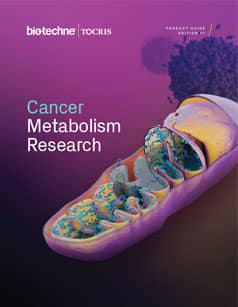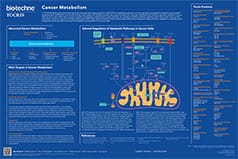Nrf2
Nrf2 is a member of the basic leucine zipper family of transcription factors. Under normal physiological conditions, Nrf2 is degraded by the concerted actions of Keap1 and Cullin 3, yet during oxidative stress, Nrf2 promotes transcription of antioxidant genes.
Nrf2 Inhibitors |
|
|---|---|
| Cat. No. | 产品名称/活性 |
| 6243 | ML 385 |
| Nrf2 inhibitor; phenotypically lethal | |
Nrf2 Activators |
|
| Cat. No. | 产品名称/活性 |
| 7018 | CBR-470-1 |
| Nrf2 activator; also PGK1 inhibitor | |
| 4737 | CDDO Im |
| Nrf2 signaling activator | |
| 6172 | INF 4E |
| Activates Keap1-Nrf2 pathway; also caspase-1 and NLRP3 inflammasome inhibitor | |
| 5625 | ML 334 |
| Inhibitor of Keap1- Nrf2 interaction | |
| 5293 | NK 252 |
| Nrf2 activator | |
| 6662 | 4-Octyl itaconate |
| Nrf2 activator; cell permeable | |
| 5707 | RA 839 |
| Nrf2 activator; inhibits Nrf2/Keap1 interaction | |
Nuclear factor (erythroid-derived 2)-like 2 (Nrf2, also known as NFE2L2) is a member of the basic leucine zipper family of transcription factors. Under normal physiological conditions, Nrf2 has a short half-life of around 20 minutes and is retained in the cytoplasm before being degraded by the concerted actions of Kelch-like ECH-associated protein 1 (Keap1) and Cullin 3. Cullin 3, a ubiquitin E3 ligase ubiquitinates Nrf2, targeting it for proteasomal degradation, in a process facilitated by the adaptor protein actions of Keap1. The Nrf2-Cullin 3-Keap1 interaction has been proposed as a crucial cellular sensor of oxidative stress.
Under conditions of oxidative or electrophilic stress, critical cytosine residues in Keap1 are disrupted, preventing the ubiquitination of Nrf2 by Cullin 3. The resultant accumulation of Nrf2 in the cytoplasm and subsequent translocation into the nucleus leads to heterodimer formation with a small Maf protein. The Nrf2-Maf heterodimer binds to the antioxidant response element (ARE) in the upstream promoter regions of several antioxidant genes. Genes whose expression is upregulated by Nrf2 activity include NAD(P)H:quinone oxidoreductase, heme oxygenase-1, glutathione S-transferases and multidrug resistance proteins (Mrps) amongst others.
Nrf2 pathway activity has shown to be impaired in several pathological states such as chronic obstructive pulmonary disease (COPD), asthma, pulmonary fibrosis and acute respiratory distress syndrome. Additionally, Nrf2 gene disruption has been shown to enhance susceptibility to emphysema after exposure to cigarette smoke. In support of this, Nrf2 gene activation in an animal model of cigarette smoke-induced emphysema has demonstrated beneficial effects, suggesting that Nrf2 is a valid therapeutic target for protecting the lung against the effects of oxidative stress.
Literature for Nrf2
Tocris offers the following scientific literature for Nrf2 to showcase our products. We invite you to request* your copy today!
*Please note that Tocris will only send literature to established scientific business / institute addresses.
Cancer Metabolism Research Product Guide
This product guide reviews some of the main areas in cancer metabolism research and lists around 150 products that can be used to investigate metabolic pathways in cancer including:
- Glycolysis
- Tricarboxylic Acid Cycle
- Lipidogenesis
- 1C Metabolism and Nucleic Acid Synthesis
- Drivers of Metabolic Reprogramming
- pH and Redox Balance
Cancer Metabolism Poster
This poster summarizes the main metabolic pathways in cancer cells and highlights potential targets for cancer therapeutics. Genetic changes and epigenetic modifications in cancer cells alter the regulation of cellular metabolic pathways providing potential cancer therapeutic targets.

